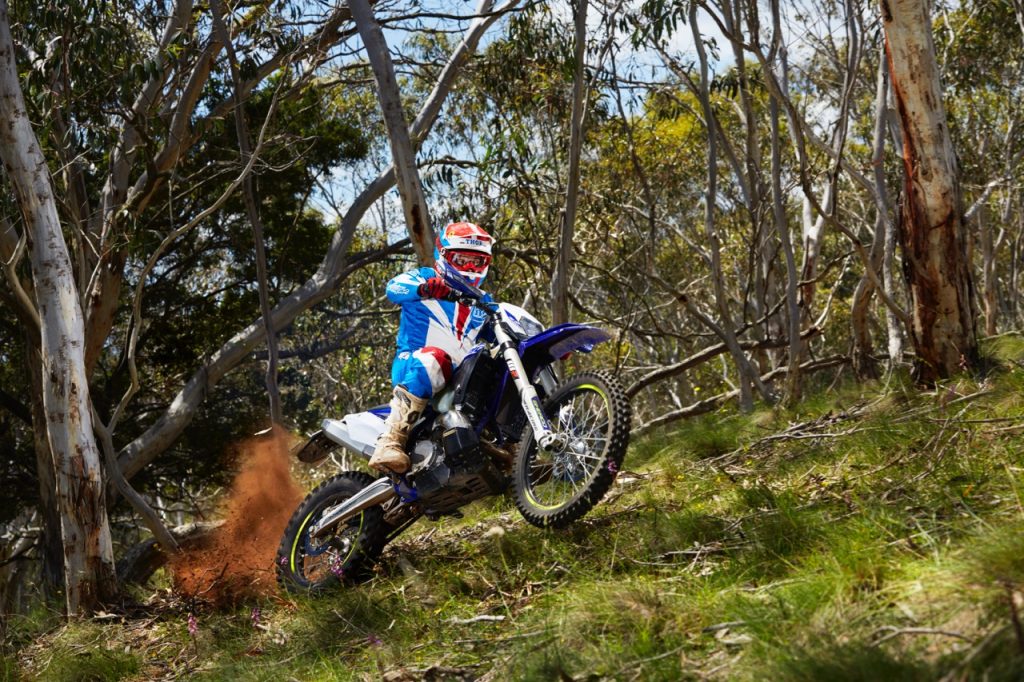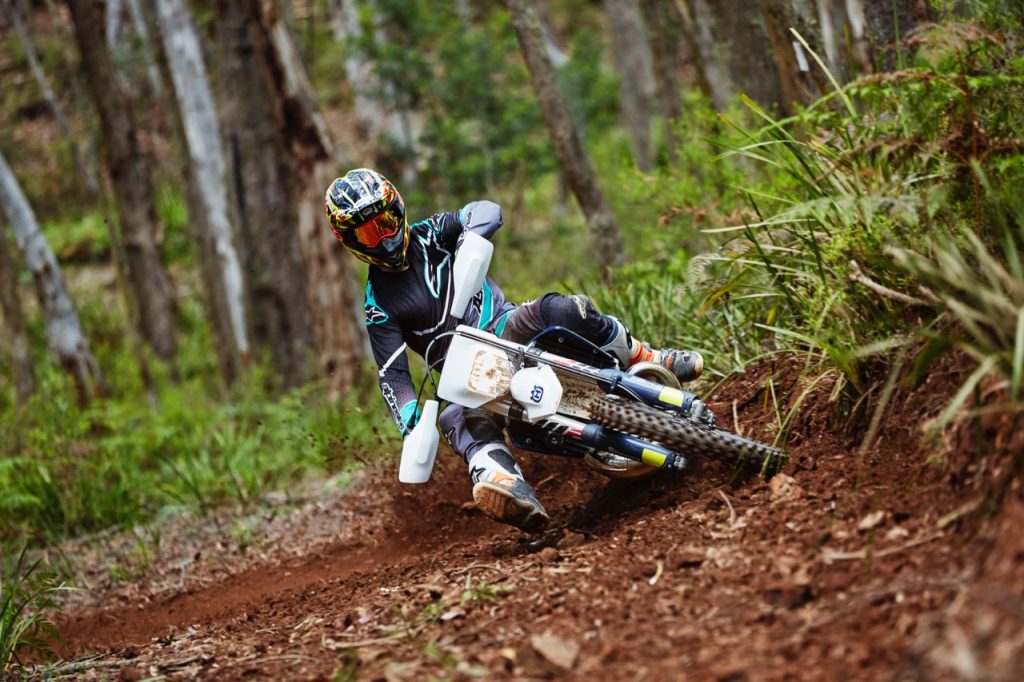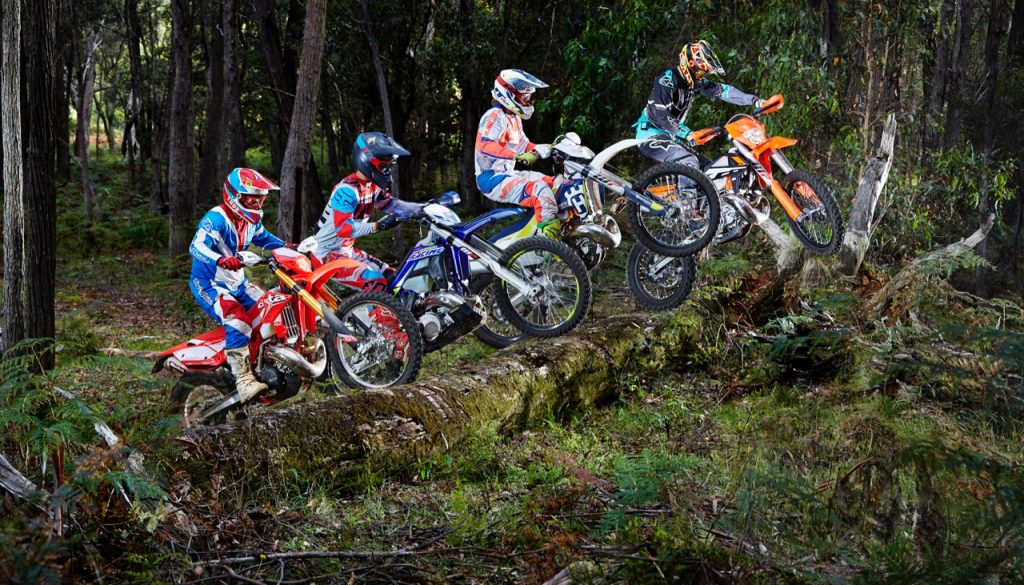We compare four 250cc two-stroke enduro bikes, the Husqvarna TE250, KTM 250EXC, Sherco 250SE-R and Beta RR250, to find out which one's best.
Words: Geoff Braico
Photos: Josh Evans
It is set to be a big year for 250cc two-stroke enduro weapons, especially in the World Enduro Championship as the FIM has changed the classes around, dropping the previous E1, E2 and E3 categories for a redefined EnduroGP (over 250cc) and Enduro2 (up to 250cc). Suddenly, 250 two-strokes are back on the game.
At home, the old E2 class rules still apply for the AORC but for how much longer? The introduction of fuel-injection next year on the Kato and Husky two-strokes to meet Euro 4 emissions laws could certainly muddy the waters.
It was time for us to kit up and see what our four challengers for the Enduro2 title had to offer.
TEST RIDERS
Tom Mason
Wil Ruprecht
Marty Wright
Geoff Braico
Beta 250RR

The Beta is the only bike at our test to have two-stroke oil injection. Riders simply have to fill the oil tank under the seat and pour straight fuel into the tank and one tank of oil will last about three rides.Having that electronic pump deliver oil into the crankcase meant that the bike was jetted spot on from the get-go. It really has smooth and useable power. Wil said: “It offers a smooth and linear power delivery which allows the bike to be used with minimal clutch.”
While the Beta does have a mellow side to it, most of our testers said it preferred to be ridden on the pipe and revved out. The suspension was revised for 2017 and is probably the best package that Beta has offered out of the crate but watch this space for 2018.
There are a few things that we worked on once the track got a bit rougher but, for the most part, it is a comfortable ride. They feel small between your legs and feel very agile at low speed. Like I mentioned before, at higher speeds, the Beta does tend to become a little unpredictable.
“I found the front end felt harsh at speed, probably because it was a little soft and was riding down in the stroke,” Tom said. Sachs is also in charge of the rear end and it also received a nice little upgrade for 2017 to give the rider more adjustability.
Much like the front, slower speeds are its domain. Driving out of corners is a piece of cake on the RR and it would crawl up and over any and every slippery section with ease. It gets the power to the ground superbly and for the average rider, that is half the battle.
There are top-shelf components on the Beta, with FMF taking care of both the expansion chamber and the muffler. Lively colour scheme, racey graphics, adjustable power valve, push-button seat, a strong electric start, Excel rims and a translucent tank top the Beta 250RR off nicely. It’s also, the cheapest bike of the four by a fair chunk of coin. Riders can buy a set of gear and it’s still cheaper than the Husky. Surprise pack of the test.
SHERCO 250SE-R

The engine of the 250SE-R is pretty solid. The 2017 comes with a new piston which is stronger, more efficient and said to last a lot longer than the previous model. The SE-R’s motor is one that prefers to be ridden hard and revved out and it’s a lot of fun.
The bike comes with a new V-Force reed assembly and updated FMF exhaust that is said to improve the low-end response. These updates are an improvement for sure but there still is a little bit of a hesitation off the bottom so you need to be on the ball with the revs.
The standard Sherco on-the-fly ignition switch on the ’bar, with its race setting and trail setting, gives the rider some options when the trails get gnarly, but all out testers preferred the race setting.
Marty noted: “The gearing felt a fraction too tall for the motor, a 13-tooth on the front would bring the bottom-end to life.” Where the 250cc engine shines is in the higher gears. Get it out onto some open trails or flowy singletrack and you will be smiling from ear to ear. It’s strong, crisp and is very fast.
The 48mm open-chamber WP fork is reliable, has been around for years and is easy to work with. Compression damping is adjustable on the fly at the top of the fork.
At lower speed, Tom noticed that the front end felt a little harsh. “The Sherco front end was much better at high speed, soaking up the big hits but at low pace, it was a little deflective.” I played around with the compression as the day went on and I felt that firming up the fork around five or six clicks and getting it to sit higher in the stroke eliminated that harshness at low speed.
Just as I said for the 300, the shock is the best feeling stocker I’ve ridden with. We ran 30mm static sag and that had the 250 staying planted and getting great drive on any surface.
It was impressive to see that the Sherco comes with the biggest tank in its class, 10.4 litres, which is still very slim and best of all, its translucent. The electric start is strong and reliable, we had no dramas with it at all, and Sherco is that confident in it that it took the kickstarter off. The quality componentry, the racey look and performance to match makes it a real contender for the E2 title.
KTM 250EXC

The 2017 250EXC’s new engine is very linear and produces very rider-friendly, usable power but we did struggle with jetting. KTM changed from PWK36 Keihen to TMX38 Mikuni carbies.
We spent the best part of a morning fine tuning the EXC’s carby, playing around with different needles, main and pilot jets. It took a while but we finally came to a setting that worked well around our loop. Apart from the carby, one of the most notable features of the new two-stroke Kato’s is the addition of a counter-balancer shaft.
It’s thanks to this new balancer that the 2017 250EXC has almost no vibration through the handlebar. All of our testers were impressed with that. The new DDS hydraulic clutch is also a nice touch, and has a great feel. Marty was surprised with the power: “It’s not an overly powerful engine, but it is so smooth and just continues to pull right from the bottom to the top of the rev range.”
Of course, if you’re after more punch out of the motor, you can play around with the different power-valve springs and fine tune it to your liking.
But the Kato was the only bike in the test that didn’t come with an ignition map switch as standard. Like the rest of the EXC range, the 250 gets WP XPlor suspension front and rear and it offers a nice ride. The 48mm USD fork is plush and gives you plenty of confidence to tip into corners at pace. Unfortunately, the stock Maxxis tyres are garbage and tend to let go just as you as getting confident.
I would be throwing a good set of tyres on there ASAP. The XPlor 48 fork is a split system similar to that of the ill-fated 4CS system that had been used in previous years with the comp on one side and the rebound on the other. Thankfully, the XPlor feels nothing like the 4CS and is actually rideable.
With the new Xplor PDS shock fitted, the KTM is quite balanced and wont beat you up even on long days in the saddle. The days of the rear end ‘packing’ on the Katos seem to have gone.
It still has that active feel that comes with PDS, kinda like you feel like it can bunny hop over any obstacle with ease. The new frame offers a flatter seat but it still feels like there is room to move. As always with KTM, the brakes are awesome and offer great feel. The ODI Lock on handgrips are a nice touch as well and seem to last a long time.
HUSKY TE250

Just like the KTM, the Husky’s engine is smooth and linear, and very easy to ride. The Husky’s powerplant is easy to handle and, just to satisfy his curiosity, we let Marty change the power valve setting. “I played around with the power valve and set it to a more aggressive setting and it made it feel like a rocket!”
As on the Kato, the jetting of the Mikuni TMX38 was an issue at the start of the day but with the same jets installed, the TE ran spot on. The feel of the Husky when you ride it is different to the KTM, which is probably due to the fact it runs a linkage.
Changes within the structure of the frame result in the bike having more flex and better bump absorption. This is most noticeable under acceleration out of corners on the choppy stuff.
The XPlor fork is the same as on Kato, but it comes with an on-the-fly preload adjuster which has six settings and is very easy. The action is as plush as on the Kato but, thanks to the linkage, the TE doesn’t feel as active beneath you. The TE also has an ignition map switch standard on the ’bar with two settings, standard and mellow. All our testers preferred the standard map.
The Husky wins the title for grippiest seat. That thing will rip your pants off if you’re not careful. The grills in front of the radiators act as braces as well which is pretty clever but you need to use tools to take them off and clean them. The Husky is the priciest bike of the four.
THE KING IS
Just like the 300T shootout we ran in March (ADB #450), you could throw a [wet] blanket over these four bikes. Gone are the days when we did a test and there was a clear winner. But for the first time we have a tie. Husky and Beta are the best 250cc two-stroke enduro bikes.
The Husky is a great race bike straight out of the box. Despite jetting issues, it made up points in the suspension department, which saw it sneak through for a joint win. The Beta is the easiest bike to ride. It isn’t the complete race package but as a trailbike it was the most comfortable

